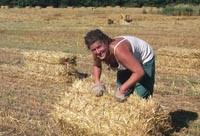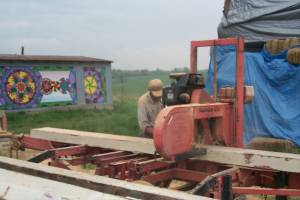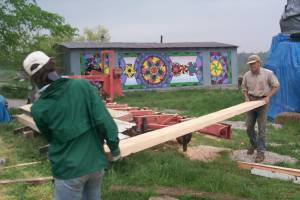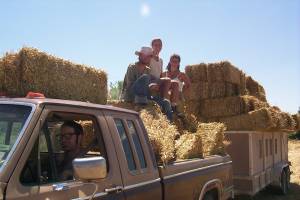The Making of Skyhouse (the building)
|
•Overview •Design •Materials •People •Foundation •Frame •Roof •Strawbales •Plaster •Floor •Heating and Cooling •Interiors •Solar Electric •Water |
MaterialsSo we at Dancing Rabbit are committed to minimizing our negative ecological impact and the embodied energy in our buildings. We have a covenant that requires us to use reclaimed or locally harvested lumber and we are always looking to use local, natural, and alternative materials.
The WoodWhile we do have a whole barnfull of reclaimed lumber, we didn't have the posts and beams necessary to work with our architects designs. So we got on the internet and the phone and started digging into the industry of reclaimed timbers.We found a wood broker in St Louis, Stockton Heartwoods who works with people who take down buildings built in the late 19th and early 20th century when people were busy deforesting our country and turning old growth into factories, warehouse, and hotels. These old buildings were made with amazing timbers - stuff you practically can't get today (and of course we'd have no part of cutting such stuff today). Much of the wood is remilled into heartwood pine flooring for upscale homes. But if you can buy the timbers as is out of the factory you can get them at a pretty reasonable rate (60 cents/bd-ft). (We also had an unfortunate situation with another broker who took our money and never got us the wood and who we we are now suing - so beware!) So we ended up with 10,000 board feet of Douglas Fir 5 x 13's - 24 feet long. That's a serious piece of wood - 400 pounds each. It took awhile to finally get them to us from the factory in Chicago but eventually the truck came and our neighbor helped us unload the monsters. After a little denailing and some picking and choosing the best of the bunch we were ready to bring in our friend Larry Ayers, our local sawyer.
We also needed decking for the second story floor and ended up finding some 100 year old Spruce 2x7 tongue and groove decking. We are hoping to make this our finished floor with a little sanding. We are hoping it goes back together easy enough.
The Straw Bales
It was a very hot summer in 1999, and during the hottest week of the year we were out picking up 3000 strawbales from a neighbors field. Skyhouse will probably use about 1500 of these with the rest going into other building projects at DR. We were able to contract directly with a local farmer and a friend with a baler to make us custom bales. We had them cut the wheat straw long and pack those bales as tight as they could. Now we are just hoping we kept them dry enough over the winter (we are still hoping to learn a better way to tarp things - what a pain).
Windows and DoorsWe were lucky enough to get a great deal on a bunch of windows and doors that a major window store had in their "bone yard". These were all brand new windows but were rejected from previous jobs for some mistake or flaw -- usually the wrong size. For one lump sum we bough the whole thing and had them delivered -- probably 100 windows, doors and other odds and ends. And we were able to piece things together and ended up with all the windows we needed for the whole building from this one source. A huge score given how expensive windows can be.Costs and FootprintingAs we buy materials, supplies and tools we are keeping careful track of the money we spend on Skyhouse. I hope to eventually post a spreadsheet here for others interested in estimating their potential costs in building with straw.We are also trying to tally the ecological impact of our building using a method called Ecological Footprinting. To do this we are trying to track both the materials and the shipping energy to get them to us. Luckily all our power tools are solar powered so we decided not to count that directly:-) Hopefully we'll have spreadsheets with that info soon too. |

 Larry came in with a WoodMizer portable bandsaw mill and helped us turn these beams into all the posts, beams, and 2nd story joists for our building. The sawing was hard work and took 5 days but in the end we had some beautiful timbers that were labelled, stacked and ready to be turned into a house.
Larry came in with a WoodMizer portable bandsaw mill and helped us turn these beams into all the posts, beams, and 2nd story joists for our building. The sawing was hard work and took 5 days but in the end we had some beautiful timbers that were labelled, stacked and ready to be turned into a house.
